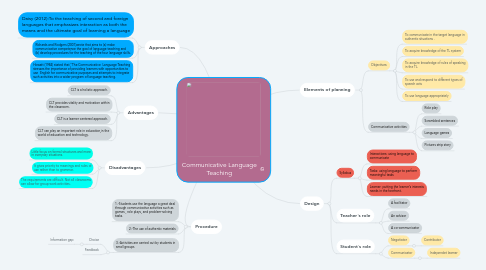Communicative Language Teaching
by noemi del pezo


1. Approaches
1.1. Daisy (2012):To the teaching of second and foreign languages that emphasizes interaction as both the means and the ultimate goal of learning a language
1.2. Richards and Rodgers (2001)wrote that aims to (a) make communicative competence the goal of language teaching and (b) develop procedures for the teaching of the four language skills.
1.3. Howatt (1984) stated that "The Communicative Language Teaching stresses the importance of providing learners with opportunities to use English for communicative purposes and attempts to integrate such activities into a wider program of language teaching.
2. Advantages
2.1. CLT is a holistic approach.
2.2. CLT provides vitality and motivation within the classroom.
2.3. CLT is a learner centered approach.
2.4. CLT can play an important role in education,in the world of education and technology.
3. Disadvantages
3.1. Little focus on formal structures and more in everyday situations.
3.2. It gives priority to meanings and rules of use rather than to grammar.
3.3. The requirements are difficult. Not all classrooms can allow for group work activities.
4. Procedure
4.1. 1.-Students use the language a great deal through communicative activities such as games , role plays, and problem-solving tasks.
4.2. 2.-The use of authentic materials
4.3. 3.-Activities are carried out by students in small groups
4.3.1. Choice
4.3.1.1. Information gap
4.3.2. Feedback
5. Elements of planning
5.1. Objectives:
5.1.1. To communicate in the target language in authentic situations .
5.1.2. To acquire knowledge of the TL system
5.1.3. To acquire knowledge of rules of speaking in the TL
5.1.4. To use and respond to different types of speech acts
5.1.5. To use language appropriately
5.2. Communicative activities
5.2.1. Role play
5.2.2. Scrambled sentences
5.2.3. Language games
5.2.4. Pictures strip story
6. Design
6.1. Syllabus
6.1.1. Interactions: using language to communicate
6.1.2. Tasks: using language to perform meaningful tasks
6.1.3. Learner: putting the learner’s interests needs in the forefront.
6.2. Teacher´s role
6.2.1. A facilitator
6.2.2. An advisor
6.2.3. A co-communicator
6.3. Student´s role
6.3.1. Negotiator
6.3.1.1. Contributor
6.3.2. Communicator
6.3.2.1. Independet learner
